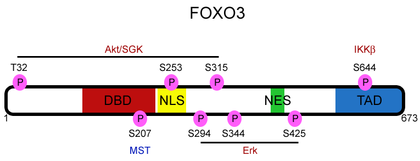This web page was produced as an assignment for Genetics 677, an undergraduate course at UW-Madison.
WEB PAGE DEVELOPMENT IN PROGRESS
FoxO3
Female Infertility
Infertility is classified as the inability to conceive after having unprotected intercourse for a year or longer. It is estimated that infertility effects 10-15% of couples and out of those couples, approximately one third of the cases are due to female infertility . Causes of infertility can range from endometriosis to hormonal imbalances to fallopian tube damage. The list of possible causes is never ending and includes environmental and genetic factors. One specific cause of female infertility is premature ovarian failure (POF) which results in the loss of ovary function before the age of 40. It is estimated to effect nearly 1% of women [2]. Causes of POF are strongly influenced by genetics as well as environmental factors such as chemotherapy and radiation. Women who are diagnosed with POF require immediate estrogen replacement therapy due to hormonal levels similar to those of menopausal women.
Foxo3 Gene
It is known that female fertility decreases with age. However, premature ovarian failure is one instance where a woman becomes infertile prematurely. The gene FoxO3 has been directly linked to the follicular development and oocyte growth. Therefore, it is a potential player in the cause of POF. FoxO3 also plays an important role in cell cycle control and apoptosis [3].
The FoxO3 gene contains a Forkhead box DNA binding domain allowing for more stable binding to DNA. Because of it's roles of cell cycle arrest and apoptosis, FoxO3 proteins are tumor suppressors. It has also been known to have inhibitory protein interactions with p53 and ER. These abilities of FoxO3 lead to the suggestion that it regulates ovarian follicular development leading to pre-mature age-dependent infertility. [1]
Effects on Fertility
As demonstrated by Ma et al.
As demonstrated by Ma et al.
This diagram by Ma et al. demonstrates where the differences occur between mice with normal fertility and infertile mice with associated FoxO3 gene. [4]
References:
[1] Brenkman, AB. and Burgering, BM. (2003) FoxO3 eggs on fertility and aging. Trends Mol Med, 9(11):464-7.
[2] Chatterjee S, Modi D, Maitra A, et al. (2007). Screening for FOXL2 gene mutations in women with premature ovarian failure: an Indian experience. Reprod. Biomed. 15 (5): 554–60.
[3] Dansen TB. and Burgering BM. (2008) Unravelling the tumor-suppressive functions of FOXO proteins. Trends Cell Biol., 18(9):421-9. ang B,
[4] Mu Y, Ni F, Zhou S, Wang J, Cao Y and Ma X. (2010). Analysis of FOXO3 mutation in 114 Chinese women with premature ovarian failure. Reprod Biomed Online. 20(4):499-503
[5] http://www.cisreg.ca/cgi-bin/tfe/articles.pl?tfid=478
[4]


